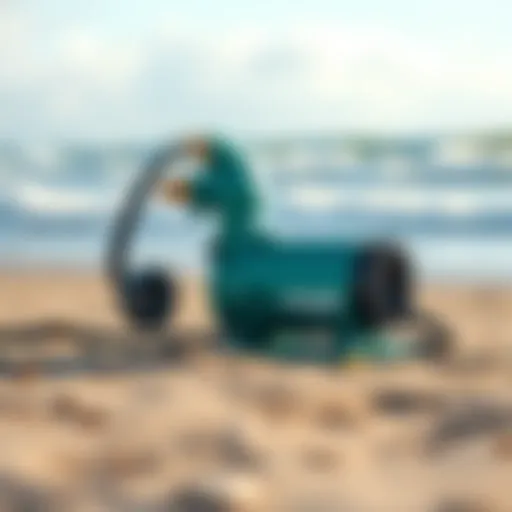Mastering E-Foiling: Techniques, Safety, and Insights


Intro
E-foiling, the cutting-edge twist on kiteboarding, has gained traction in recent years, captivating enthusiasts who crave the thrill of gliding over water with minimal resistance. This innovative sport allows riders to harness electric propulsion for a unique experience, blending the exhilaration of surfing with the art of flying. Understanding the finer points of e-foiling requires more than just enthusiasm; it demands a keen insight into techniques, equipment, and environmental factors that can influence performance.
As we dive deeper into e-foiling, we’ll explore beginner and advanced techniques designed to help both novices and seasoned riders optimize their skills. We'll also dissect the critical components of e-foiling gear, ensuring you make informed choices tailored to your specific needs. Understanding local conditions adds another layer to the sport, enabling individuals to strategize for optimal performance.
Let's get started, shall we?
Techniques for Kiteboarding Enthusiasts
Mastering e-foiling is not just about hopping on the board; it involves a series of refined techniques that can elevate your ride from ordinary to extraordinary. This section will unravel the skills necessary for both beginners and advanced practitioners, ensuring a comprehensive grasp of the sport.
Beginner Techniques
Starting out in e-foiling can feel intimidating for some. Here are a few key points to keep in focus:
- Body Positioning: Keeping a low center of gravity is essential. Bend your knees slightly, keeping your hips back and arms straight. This position grants better control and balance while riding.
- Launch Technique: Start by getting comfortable with the board on just the water. Allow the board to float, slowly adding pressure to the gas (electric motor) as you gradually lean forward, lifting off the water surface.
- Turning: Use your back foot to apply pressure on the tail of the board while shifting your weight towards your front foot for smoother turns. It’s all about subtle adjustments and finding the sweet spot for maneuverability.
Advanced Maneuvers
Once you’re confident with the basics, it’s time to elevate your skills further. Consider focusing on these advanced techniques:
- Carving: Carving is all about smooth, sweeping turns. By leaning into your turns while maintaining your balance, you can create beautiful arcs on the water surface.
- Jumping: For those looking to add flair, learning to jump involves timing your weight shift and accelerating just before lifting off. Your knees should bend during the jump to help absorb the fall, ensuring a smoother re-entry.
- Riding Backwards: Mastering the art of riding backwards can impress fellow kiteboarders. Start with gentle turns, gradually shifting your weight back while maintaining direction with your front hand.
"The beauty of e-foiling lies in the graceful dance between rider and wave—an exhilarating harmony that invites continuous exploration."
Equipment Insights
In the world of e-foiling, having the right gear is paramount for both performance and safety. This section will cover essential pieces of equipment that elevate the experience, along with reviews of popular products currently making waves.
E-Foil Board Reviews
- Lift Foils 3 Series: Known for its high-quality build and excellent performance, the Lift Foils board allows for smooth rides even in choppy waters. Its versatility makes it a popular choice among both beginners and adept riders.
- Radinn Freeride: The Radinn emphasizes speed and agility. Featuring a powerful battery and customizable ride modes, it is perfect for those wishing to push the limits of their e-foiling experience.
Special Mention: Safety Equipment
When it comes to safety gear, don't cut corners. Essential items include:
- Impact Vest: To protect against falls and ensure buoyancy.
- Helmet: Always wear one to avoid head injuries, especially when practicing maneuvers.
End
E-foiling opens the door to a thrilling adventure on the water, blending fun with a dose of responsibility. From mastering essential techniques to selecting the right gear, it all contributes to a rewarding experience. As you embark on your e-foiling journey, remember to keep refining your skills and stay aware of environmental factors.
For more information on kiteboarding and water sports, consider visiting Wikipedia or Britannica.
Prolusion to E-Foiling
The realm of e-foiling has been blossoming over the years, seamlessly marrying technology with the exhilaration of water sports. For kiteboarders and water sports instructors, understanding the nuances of this innovative discipline is not just a matter of keeping up, but also of enhancing one’s overall experience with it. E-foiling presents an intriguing combination of skill, balance, and connectivity with the environment. The comprehensive exploration of this topic goes beyond the mere act of riding; it invites one to appreciate the artistry behind the equipment, the finesse required in maneuvers, and the sheer pleasure found in gliding over waves.
Whether you’re a novice looking to dip your toes or a seasoned rider aiming to sharpen your skills, grasping the core concepts of e-foiling lays the groundwork for a more fulfilling adventure. From the interplay of power and balance to the subtleties of board dynamics, each element weaves into the larger tapestry of e-foiling.
What is E-Foiling?
At its core, e-foiling utilizes an electric motor attached to a board to enable riders to lift above the water's surface. Picture this: you’re gliding effortlessly, suspended with minimal drag, feeling the wind and water in a manner that few other water sports can replicate. The mechanics involve a foil submerged underwater that generates lift as it moves. This lift allows the rider to rise above the water, thereby transforming a simple ride into something magical.
For many, the charm lies in the sensation of flight that e-foiling provides. The unique experience of hovering, coupled with the excitement of controlling one’s speed and direction, draws enthusiasts from various backgrounds into the sport. The beauty of it is that it offers a relatively gentle learning curve due to the board's stability and the gradual power delivery of the motor, making it accessible for those new to water sports.
The Evolution of E-Foiling
Reflecting on the evolution of e-foiling reveals a journey that mirrors advancements in technology and a growing interest in innovative water sports. Initially conceived as an elevated form of traditional surfing and kiteboarding, e-foiling has now carved its niche as a standalone sport. The very first e-foils were rudimentary at best, often cumbersome, and lacked the finesse seen today. However, with rapid advancements in electric battery technology, materials science, and watercraft design, today's e-foils have become sleek and highly efficient.
As e-foiling gained traction, its community began to flourish. Like any burgeoning sport, e-foiling has its enthusiasts sharing insights on forums like Reddit or groups on platforms like Facebook, fueling discussions around best practices and equipment recommendations. Riders now have access to a plethora of resources that help them refine their technique, from understanding battery management to mastering those tricky turns.
This transformation within the sport reflects a broader trend; as more people become environmentally conscious, e-foiling offers a quieter, cleaner way to enjoy the water without the noise and fuel consumption associated with traditional motorized sports. From discussions around safety measures to the importance of picking suitable locations, the past few years have certainly shaped the present landscape of e-foiling, propelling it towards untold future possibilities.
Fundamental Lessons in E-Foiling
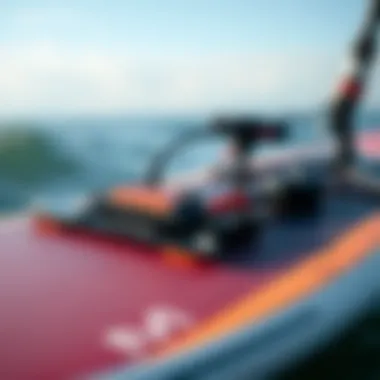
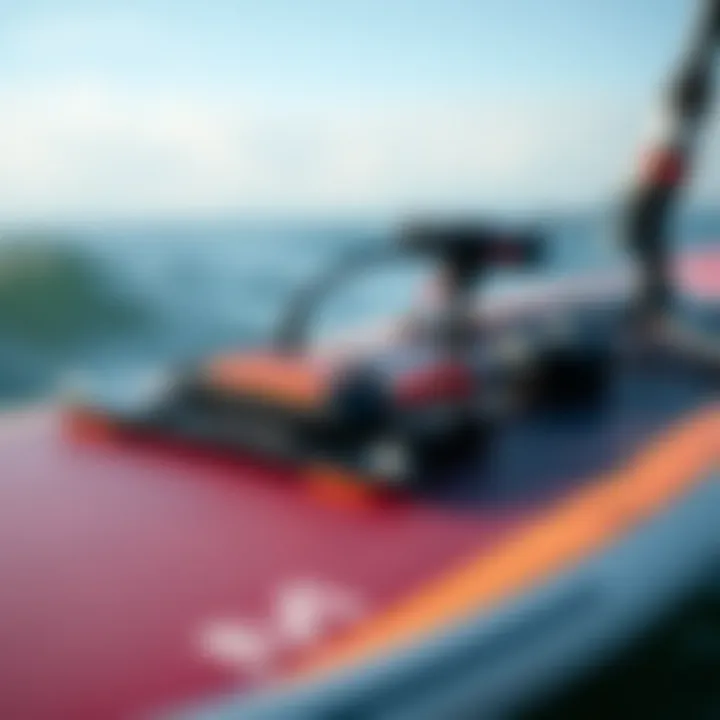
The art of e-foiling, like any nuanced sport, relies heavily on foundational principles which can significantly enhance the experience and safety on the water. This segment explores essential lessons vital for anyone wanting to maneuver through the waves with confidence and skill. Understanding these fundamentals not only promotes effective performance but also boosts enjoyment and minimizes risks during e-foiling adventures.
Understanding the Foil Dynamics
To truly grasp e-foiling, one must delve into the intricacies of foil dynamics. The foil itself operates through a unique mechanism of lift and drag, something that might seem complex at first. That said, the lift produced by the hydrofoil is what elevates the board above the water surface, reducing drag and allowing for smooth gliding.
Key points to keep in mind include:
- Angle of Attack: The angle at which the foil meets the water directly affects the lift and stability. Small adjustments can lead to significant changes in performance.
- Speed and Lift Relationship: Faster speeds typically generate more lift. However, there's a balance to strike—going too fast might lead to loss of control.
- Foil Size and Shape: Different foil sizes can accommodate varying conditions. A larger foil might give better lift in choppy waters, while a smaller foil can be ideal for smoother rides.
Taking the time to understand these foil dynamics can lead to a more enjoyable e-foiling experience, setting the stage for further exploration of skills and techniques.
Mastering Balance and Body Positioning
In e-foiling, balance is just as crucial as your gear. Proper body positioning ensures that you maintain control and leverage the foil's capabilities effectively. All of that said, maintaining body balance can be challenging when you first start out.
Here are some key tips:
- Knees Bent: Keeping your knees slightly bent helps absorb any choppiness in the water. This flexible stance also helps in maintaining stability and adapting to changes.
- Center of Gravity: Your feet should be placed shoulder-width apart at the center of the board, adjusting your weight forward or backward depending on your speed and conditions.
- Look Ahead: Always focus on where you want to go, not on the water directly in front of you. This not only keeps you balanced but enhances your overall control.
Balancing takes practice. By regularly evaluating your position on the board, you can develop muscle memory, leading to more enjoyable rides.
Navigating Power and Speed Control
Controlling power and speed on an e-foil is crucial, especially for beginners. It can be tempting to crank up the speed and just ride the waves, but managing your throttle is where the real mastery lies. Achieving that perfect sweet spot can significantly improve your overall experience.
Important factors to consider include:
- Throttle Management: Gradually increase your throttle to avoid sudden jerks. Smooth accelerations help maintain stability and enhance control.
- Wind and Water Conditions: Understanding how different conditions affect speed is essential. For instance, windy days can change how your board interacts with the water.
- Practice Stopping: Learning to reduce speed and come to a controlled stop can prevent accidents. Practice using the throttle carefully, gradually easing it back to achieve this.
Navigating power and speed effectively not just enhances performance but also instills greater confidence during rides.
Effective Turning Techniques
Turning on an e-foil can present its own set of challenges, but with practice, it can become second nature. Mastering turning techniques allows you to change direction fluidly and navigate obstacles with ease.
Some tips for effective turning include:
- Weight Shift: Leaning into the turn while shifting your weight provides the necessary tilt for the foil to achieve a proper angle.
- Use Your Arms: Extended arms can aid in balance during turns. Engage your core and use slight upper body movements to assist in guiding your board to the desired direction.
- Practice Carving: Rather than sharp turns, focus on carving, which involves gradual, fluid motions. This will help maintain speed and control.
By honing these techniques, you lay the groundwork for more advanced maneuvers as your skills progress.
"Mastering the fundamentals of e-foiling not only enhances your skill set but also enriches the experience, allowing for better interaction with the environment on every ride."
As you explore these fundamental lessons, keep in mind that practice is the key to mastering the sport. Take your time, focus on each aspect, and before you know it, you’ll be gliding over the water with ease.
Safety Protocols and Best Practices
Safety in e-foiling is not merely a set of guidelines; it's a fundamental aspect that ensures enjoyment and longevity in the sport. As the thrill of gliding above the water beckons the adventurous, understanding the importance of safety protocols can significantly contribute to your overall experience. Neglecting these practices can lead to unfortunate incidents that not only affect your wellbeing but can potentially spoil the fun for others around you.
With that in mind, let's delve into critical safety considerations that every e-foiler should be aware of.
Pre-Flight Safety Checks
Before embarking on your e-foiling adventure, conducting thorough pre-flight safety checks is essential. This process is akin to a pilot going through their checklist before a flight; it ensures that everything is functioning and ready for action. Here are some key checks to keep in mind:
- Battery Check: Make sure your battery is fully charged and securely connected. A sudden power loss while riding can be hazardous.
- Foil Inspection: Look for wear and tear on your foil and board. Damaged parts can affect performance and increase the risk of accidents.
- Wiring Examination: Inspect the wiring and connections of the e-foil system. A frayed wire could lead to electrical issues.
- Personal Equipment Review: Ensure your personal flotation device is intact, and inspect your wetsuit, helmet, and other gear for any damage.
"A little prevention goes a long way in ensuring a thrilling yet safe experience on the water."
Challenging Conditions and Risk Management
E-foiling is often best enjoyed in calm, favorable weather conditions; however, sometimes you might find yourself facing challenging weather. Wind, waves, and changing tides can add risk, demanding heightened awareness. Here are a few risk management strategies:
- Stay Informed: Check weather updates and water conditions prior to heading out. Wind gusts over 15 knots can make stabilization tricky for beginners.
- Choose Your Location Wisely: Opt for areas free from boat traffic or obstacles like rocks and numerous swimmers. These can complicate your ride and reduce visibility.
- Riding Together: Whenever possible, ride with a buddy. Having someone else nearby can provide immediate support in case of an incident.
- Know When to Call It Quits: Accept that not every day is the right day for e-foiling. Conditions can change rapidly; don’t hesitate to postpone if safety is of concern.
Personal Protective Equipment Recommendations
Equipping oneself with proper personal protective gear is a non-negotiable aspect of safety. While the thrill of the e-foil ride can tempt some to skimp on safety measures, the following items should be standard:


- Personal Flotation Device (PFD): Always wear a USCG-approved life vest. This is not just wise; it's mandatory in many areas.
- Impact Vest: For added protection against falls, an impact vest can cushion your body against the water and any hard impacts.
- Helmet: A well-fitted helmet protects your head from injury if you take a tumble or collide with obstacles.
- Leash: A board leash can prevent your board from drifting away after a fall, ensuring you can retrieve it without needing to swim far.
Analyzing E-Foiling Equipment
The world of e-foiling is as much about the gear as it is about the technique. Understanding your equipment can dramatically affect your performance and enjoyment on the water. Each piece of gear plays a crucial role in how you experience e-foiling, from the board you choose to the battery that powers your ride. In this section, we’ll break down several key components: the e-foil board itself, the battery systems, and how to set up and configure your foil appropriately.
Choosing the Right E-Foil Board
Selecting the right e-foil board is like picking the shoes for a dance – the right fit makes all the difference. Consider your body weight, experience level, and the conditions you plan to ride in. Larger boards generally offer more stability and buoyancy, perfect for beginners. They allow for easier balance, making the learning curve a bit less steep. On the flip side, if you're looking to perform tricks and maneuvers, a smaller board might suit you better, providing increased agility and responsiveness.
When choosing, be mindful of the board's construction material as well. Boards made from lightweight epoxy are often favored for their combination of strength and buoyancy. However, they can be pricier, so weigh your options well. If unsure, head to local shops or forums like Reddit’s e-foiling community to gather insights from experienced riders.
- Pros of Larger Boards:
- Cons of Smaller Boards:
- Increased stability for beginners.
- Greater buoyancy for slower speeds.
- Less stable; can be challenging for beginners.
- Might require more skill for sharp turns.
Understanding Battery Systems and Lifespan
Your e-foil’s battery is like the heart of the system, pumping life into the ride. Understanding the intricacies of battery systems can help you pick the right one for your adventures. E-foils generally rely on lithium-ion batteries due to their energy density and recharging capabilities. Most batterys range broadly in capacity, often measured in amp-hours (Ah).
A higher capacity not only provides longer ride time but also determines the maximum speed and overall performance. For example, a battery rated at 30 Ah will allow for extended sessions compared to one rated at 20 Ah. However, keep in mind that the weight of larger batteries can affect board integrity and maneuverability.
Keep an eye out for lifespan too, which is often noted in the number of charge cycles a battery can endure before its efficiency drops off. With proper care, a lithium-ion battery can usually last three to five years. Regularly check for signs of wear and tear, and store your battery in a controlled environment to maximize its life.
Foil Setup and Configurations
Getting the foil setup right is crucial to unlocking the full potential of your e-foil. It’s where science meets art; you need to balance lift and drag to glide effortlessly across the water. The configuration of the mast, wings, and fuselage can drastically change how your board behaves.
The mast height usually falls within the 60-80 cm range for most riders. A longer mast generally allows for more clearance above the water, making it easier to navigate choppy waters, while shorter masts offer better stability in calmer conditions. Additionally, the size of the front wing significantly contributes to lift. Bigger wings can carry more weight and are ideal for slower speeds or beginners, while smaller wings excel for faster rides and sharp turns.
Key Considerations for Foil Setup:
- Mast Height: Higher mast for choppy waters, lower for calm.
- Front Wing Size: Larger wings for stability and slower rides, smaller for advanced maneuvers.
- Fuselage Length: Longer fuselages can provide enhanced stability; shorter ones might yield more responsiveness.
Having the right setup can change the game. Spend a little time adjusting and experimenting with different configurations to see what feels best. Visit forums or join e-foiling groups to share insights and tips, and make your time on the water as enjoyable as possible.
"The right equipment is only half the battle; knowing how to use it makes all the difference."
Whether you're a newcomer or a seasoned rider, ensuring your e-foiling gear is perfectly dialed in can lead to exhilarating experiences on the water. Take the time to analyze each component carefully, and you’ll find that every ride pushes your limits just a little further, weaving together skill, technique, and the thrill of the ride.
Locations for Optimal E-Foiling
When it comes to e-foiling, the location can be the make or break factor for your experience. Choosing the right spot not only enhances your performance but also contributes to your enjoyment on the water. It's akin to selecting the right stage for a performance; the setting will amplify every maneuver and trick you perform.
Identifying Ideal Water Conditions
The water conditions can be as vital as the equipment you ride. You want a body of water that’s not too choppy yet has enough movement to create some excitement. Ideally, look for:
- Flat Water: Lakes or calm bays are perfect for beginners, allowing for easier balance and control.
- Slight Chop: For more advanced riders, a little bit of wave can add thrill as you learn to master the foiling technique.
- Wind Variability: Consistent winds are great, but strong gusts can lead to instability.
It's wise to check local forecasts and grab insights from local water sports communities for the best times to hit the water. Speaking of which, sites like Windy can give a clear picture of wind speeds and wave heights for specific locations.
Seasonal Considerations for E-Foiling
Every season brings its own flavor to e-foiling. Just as one would adapt their wardrobe for the changing weather, it’s worthwhile to recognize how seasons affect water sports:
- Spring: Generally marks the start of e-foiling season in many places, as conditions begin to stabilize. The water may still be on the chilly side, so a wetsuit is often necessary.
- Summer: Offers ideal conditions with warmer water and consistent breezes, perfect for all levels. Popular tourist destinations can become crowded, so consider timing your sessions accordingly.
- Fall: Can be a hidden gem as many tourists leave, and the unpredictable winds can create unique opportunities for the adventurous. Crisp air can be refreshing, too!
- Winter: While it’s often considered off-season, some locations have milder winters, and the lack of wind can mean fewer chop conditions to disrupt your ride.
Balancing your sessions with weather predictions and local climate trends can maximize your e-foiling experiences throughout the year.
Top Global Locations for E-Foiling Adventures
If you really want to take your e-foiling to the next level, there are certain locations around the globe that stand out:
- Hawaii, USA: With its warm waters and steady trade winds, Hawaii is often regarded as a mecca for water sports enthusiasts. Some of the best spots include Kailua Bay and Maui.
- Cape Town, South Africa: Known for its stunning landscapes, Cape Town offers variable conditions but is especially known for strong winds, making it a great location for skilled riders.
- Baja California, Mexico: The calm waters of La Ventana provide a perfect playground for e-foilers, especially during the winter months when wind conditions are optimal.
- Gold Coast, Australia: With its consistent surf and warm water, the Gold Coast is a hotspot for all kinds of water sports. The scenic views add a cherry on top to an exhilarating e-foiling experience.
- The Caribbean Islands: Places like the British Virgin Islands provide stunning backdrops coupled with calm and shallow waters ideal for both beginners and seasoned foilers.
Ultimately, the choice of location can elevate your e-foiling experience, turning a simple outing into an unforgettable adventure. Seek out spots that resonate with your skill level and desired challenges, and don't hesitate to connect with local e-foiling communities online through platforms like Reddit or engage in specialized groups on Facebook.
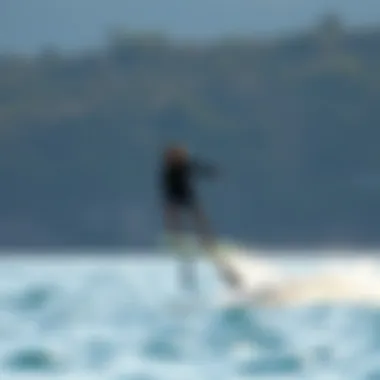
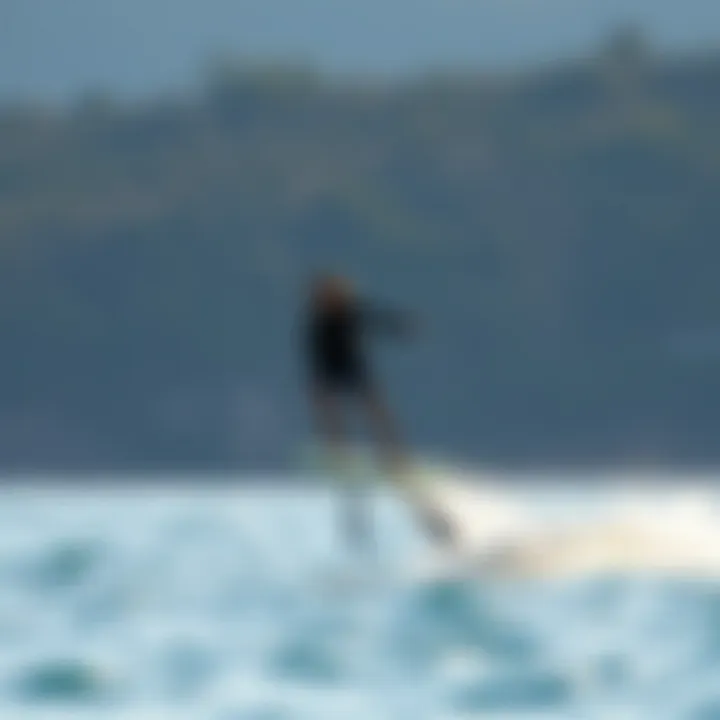
"The ocean stirs the heart, inspires the imagination and brings eternal joy to the soul."
With the right conditions and locations, the world opens up for a thrilling e-foiling journey, ripe with opportunities to learn, share, and grow in this vibrant sport.
Advanced E-Foiling Techniques
Advanced e-foiling techniques can elevate the sport from a leisurely ride to an exhilarating experience. Understanding these techniques is not just about performing elaborate maneuvers; it’s about enhancing your overall functionality on the water. As you dive deeper into e-foiling, integrating advanced techniques can dramatically improve your ride, allowing you to harness speeds, execute stunning tricks, and balance perfectly over water.
Performing Tricks and Maneuvers
Performing tricks and maneuvers is often where e-foiling really shines. Tricks range from simple to complex and provide an opportunity to express individual style while showcasing skill. To keep it interesting, here are some popular maneuvers to consider:
- Jumping: This often starts with building speed; then you shift your weight backward to lift the board from the water’s surface, ideally landing smoothly back on the foil, which requires precise timing and balance.
- Spins: A captivating visual, spins demand a good bit of agility. Initiate a 180 or 360-degree spin by surveying the horizon, turning the board while maintaining a stable body position. Balance is crucial here as it determines success.
- Sliding: Sliding requires a gentle touch on the board’s nose while shifting your weight toward the rear. Keeping momentum is key, and a smooth entry into a slide can leave your peers in awe.
To master these maneuvers, practice in controlled settings before progressing to more challenging environments. Remember, the goal is to maintain control while navigating these tricks.
"The thrill of e-foiling lies not just in riding but pushing boundaries and exploring new possibilities."
Harnessing Wind Power Effectively
Harnessing wind power is a crucial technique for maximizing efficiency while e-foiling. Instead of solely relying on the electric motor, combining wind power can extend your ride time and enhance your overall performance.
To achieve harnessing wind effectively, consider the following:
- Adjust Your Positioning: Leaning your body slightly back and shifting your weight can allow you to ride with the wind more efficiently. This positioning creates a natural balance that allows for a smooth ride even when the wind changes.
- Utilize Lean Angles: Experimenting with different lean angles can help you catch the best gusts, optimizing speed and control. Adjust your stance according to wind direction and strength, which can make all the difference in your performance.
- Combine Techniques: When you combine wind’s natural force with the motor, you gain a considerable advantage. Know when to rely on your motor and when to let the wind do the work.
Using wind intelligently can not only elongate your time on the water but also provide a fresh learning curve in your e-foiling journey, blending the mechanical and natural elements beautifully.
Community Insights and Resources
In the world of e-foiling, the significance of community cannot be overstated. Connecting with fellow enthusiasts and tapping into collective wisdom can accelerate one’s learning curve and significantly enhance the overall experience. The camaraderie among e-foilers fosters a culture of sharing knowledge, troubleshooting issues, and celebrating one another's achievements, leading to a richer sense of belonging within the sport. This section delves into how community insights can be a game changer for both beginners and seasoned riders.
Connecting with Fellow E-Foilers
Life with e-foiling is much more enjoyable when you have people to share it with. Making connections! with fellow e-foilers opens the door to a treasure trove of shared experiences and tips. Whether it’s exchanging stories on social media, meeting up at the beach, or joining local clubs, engaging with other riders can provide invaluable insights into both common and unique practices in the field.
By adapting to these shared strategies, new riders can learn how to maneuver more effectively or identify the best conditions for their first ride. Plus, having friends to ride with not only offers safety in numbers but also a support system for those inevitable wipeouts and learning experiences.
Consider joining platforms like Facebook Groups or Reddit communities tailored for water sports enthusiasts. You can find groups dedicated to e-foiling where members share local meet-ups or conduct Q&A sessions about equipment or techniques. Building these connections not only enriches one’s skills but also enhances enjoyment in the sport.
Online Resources and Learning Platforms
The abundance of resources available online today makes it easy to turn passion for e-foiling into expertise. Numerous platforms are tailored for beginners and advanced riders alike, ensuring a steady flow of learning opportunities. Some key elements of these resources include:
- Video Tutorials: Websites like YouTube are filled with countless tutorials offering insights into specific techniques and tricks from the pros. Watching experienced riders can provide guidance on body positioning and equipment handling that words alone might not convey.
- Webinars and Online Courses: A host of platforms like Udemy or Skillshare often feature specialized courses focusing on the subtleties of why and how e-foiling works.
- Forums and Discussion Boards: Participating in forums such as those on Reddit can offer quick answers from a community that shares a common passion. It’s a great way to resolve specific issues or discover hidden gems about gear and locations.
Utilizing these resources can vastly improve understanding, techniques, and enjoyment in the sport. However, it's essential to stay engaged and actively contribute to the communities, as sharing your own insights can deepen your connection to the sport while giving back to the community.
"In community, much achievement thrives, yet solitude hinders the spirit of adventure."
Ultimately, leveraging community insights and available resources could mean the difference between simplicity and mastery in e-foiling. By embracing both, riders can truly elevate their experience and skills.
Ending and Future Directions
As we wrap up our exploration of e-foiling, it becomes clear that the sport is not just about gliding above the water, but about combining technology, skill, and a deep love for the outdoors. The importance of the concluding remarks lies in their capacity to guide both novice and seasoned e-foilers towards a brighter future in this exhilarating sport. Not only does e-foiling bring joy and a sense of freedom, but it also encourages community building and knowledge sharing among enthusiasts. By looking toward the future, we can identify pathways for growth and innovation in the e-foiling ecosystem.
The Growing Popularity of E-Foiling
E-foiling has been steadily gaining traction among water sports aficionados. The quick start-up time, minimal learning curve, and sheer thrill of riding on a hydrofoil attract a wide demographic—from young thrill-seekers to older enthusiasts eager to escape the daily grind.
The appeal lies not just in the sport itself, but also in its ability to adapt to various environments. You might catch a group of e-foilers catching waves at the beach one day, then cruising the calm waters of a lake the next. This versatility makes it feel accessible to many.
Moreover, community engagement plays a significant role in bolstering e-foiling's popularity. Organizing local meet-ups, workshops, or buddy systems can spark interest and encourage more people to get involved. Whether through social media platforms like Facebook groups or discussions on Reddit, people share tips, experiences, and even gear purchases that help newcomers find their way into the sport. Just as kiteboarding opened up new avenues for water sports enthusiasts, e-foiling is positioned to do the same, becoming a lifestyle for many.
Technological Innovations on the Horizon
The future of e-foiling is primed for impressive technological advancements. With industries continuously pushing boundaries in battery technology, drone design, and materials engineering, we can expect more efficient batteries with longer lifespans and better charge times, enhancing our time on the water exponentially.
Innovation in design will allow for lighter, more portable rigs, simplifying transport without compromising performance. Advances like flexible and durable materials may pave the way for new, user-friendly devices that even first-time users can handle with ease.
One particular trend worth noting is the integration of smart technology. More manufacturers are exploring digitization, potentially creating applications to monitor performance metrics, battery levels, and even route tracking as you glide above the surface.
"In technology, as in all things, those who fail to innovate are left behind. The e-foiling community must embrace new tools to stay at the forefront of this thrilling sport."
In summary, the conclusion of this article reflects a hopeful outlook toward e-foiling’s future. With burgeoning popularity and the promise of technological innovations, enthusiasts can expect a vibrant and evolving landscape. E-foiling isn't merely a hobby; it's shaping into a movement, one where every ride contributes to a larger story woven by the community and technological breakthroughs.















